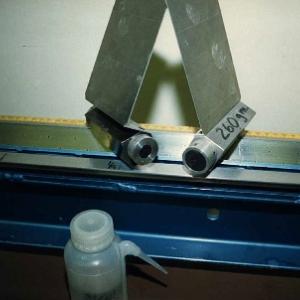College of Liberal Arts & Sciences
1N30.30 - Elastic & Inelastic Collision of Solids - Air Track
The air track should be cleaned with a soft cloth and alcohol or acetone. Assemble the cars as desired by inserting springs or magnets into the end mounting of the cars. The spring loaded timer cars may also be altered in this fashion. For this demonstration to work effectively the two cars that are being collided need to have different magnets. One car should have a large magnet and this car should also be the non-moving car. This is due to the fact that the large magnet has a significant amount of magnetic damping. The moving car should have a small magnet.
- Roger F. Larson, "Sensor Cart Collisions and the Conservation Laws", TPT, Vol. 62, #7, Oct. 2024, p. 599.
- Mahardika Prasetya Aji, Ita Rahmawati, Nisrina Imtinan, Hestining Ajeng Permatasari, Husnul Hidayah, Suharto Linuwih, Aan Priyanto, Yusmantoro Yusmantoro, "Analyzing the Center of Mass in Collisions Using Video Analysis", TPT, Vol. 60, #8, Nov. 2022, p. 699.
- Christopher Sirola, "May the Forces Be with You!", TPT, Vol. 56, #2, Feb. 2018, p. 118.
- Patrik Vogt, Jochen Juhn, "Analyzing Collision Processes with the Smartphone Acceleration Sensor", TPT, Vol. 52, # 2, Feb. 2014, p. 118.
- Patrick Twomey, Colm O'Sullivan, John O'Riordan, Stephen Fahy, "Collisions with Springs: A Useful Context for the Study of Analytical Dynamics", TPT, Vol. 50, # 2, Feb. 2012, p. 83.
- Nattakit Sawadthaisong, Ratchapak Chitaree, James Barufaldi, "Demonstration of Momentum and Kinetic Energy During an Entire Collision", TPT, Vol. 49, # 1, Jan. 2011, p. 56.
- Paul Gluck, "Elastic and Inelastic Collisions", TPT, Vol. 48, # 3, Mar. 2010, p. 158.
- "Figuring Physics", TPT, Vol. 46, # 4, April 2008, p. 245.
- Deb Funk, "Elastic Collisions with Two Moving Objects Made Simple", TPT, Vol. 44, # 2, Feb. 2006, p. 80.
- Xueli Zou, "Making 'Internal Thermal Energy' Visible", TPT, Vol. 42, # 6, Sept. 2004, p. 343.
- Hasan Fakhruddin, "Maximizing Imparted Speed in Elastic Collisions", TPT, Vol. 41, # 6, Sept. 2003, p. 338.
- Hui Hu, 'More on One-Dimensional Collisions", TPT, Vol. 40, # 2, Feb. 2002, p. 72.
- Kurt T. Loveland, "Simple Equations for Linear Partially Elastic Collisions", TPT, Vol. 38, # 6, Sept. 2000, p. 380.
- C.T. Tindle, "An Intuitive Approach to Collisions", TPT, Vol. 36, # 6, Sept. 1998, p. 344.
- A. P. French, " 'Intuitively Obvious'?", TPT, Vol. 36, # 8, Nov. 1998, p. 353.
- Chris Tindle, "Tindle Responds", TPT, Vol. 36, # 8, Nov. 1998, p. 454.
- L. Edward Millet, "The One-Dimensional Elastic-Collision Equation: nf= 2nc-ni ", TPT, Vol. 36, # 3, Mar. 1998, p. 186.
- Irina E. Lyublinskaya, "Central Collisions - the General Case", TPT, Vol. 36, # 1, Jan. 1998, p. 18.
- Cathy Abbot, "Pretty Cool" Collision Experiment", TPT, Vol. 35, # 7, Oct. 1997, p. 397.
- P. Roura, "Collision Duration in the Elastic Regime", TPT, Vol. 35, # 7, p. 435- 436, Oct. 1997.
- Ian R. Gatland, "Relative Speed in Elastic Collision", TPT, Vol. 33, # 2, Feb. 1995, p. 98.
- Uri Ganiel, "Elastic and Inelastic Collisions: A Model (or What Happens to the Kinetic Energy?)", TPT, Vol. 30, # 1, Jan. 1992, p. 18.
- Nicholas E. Brown, "Impulsive Thoughts on Some Elastic Collisions", TPT, Vol. 23, # 7, Oct. 1985, p. 421 - 422.
- C. B. Price, M. L. Pethybridge, "Elastic Collisions on a Simulated Circular Air Track", TJP, Vol. 92, #11, Nov. 2024, p. 841.
- F. Herrmann, "Demonstration of a Slow Inelastic Collision", AJP, Vol. 54, #7, July 1986, p. 658.
- R. H. Romer, "Matrix Description of Collisions on an Air Track", AJP, Vol. 35, # 9, Sept. 1967, p. 862.
- David Kutliroff, "70, Elastic Collisions Without Physical Contact", 101 Classroom Demonstrations and Experiment For Teaching Physics, p. 154.
- Md- 3, 4, Mg- 3, 4: Freier and Anderson, A Demonstration Handbook for Physics.
Disclaimer: These demonstrations are provided only for illustrative use by persons affiliated with The University of Iowa and only under the direction of a trained instructor or physicist. The University of Iowa is not responsible for demonstrations performed by those using their own equipment or who choose to use this reference material for their own purpose. The demonstrations included here are within the public domain and can be found in materials contained in libraries, bookstores, and through electronic sources. Performing all or any portion of any of these demonstrations, with or without revisions not depicted here entails inherent risks. These risks include, without limitation, bodily injury (and possibly death), including risks to health that may be temporary or permanent and that may exacerbate a pre-existing medical condition; and property loss or damage. Anyone performing any part of these demonstrations, even with revisions, knowingly and voluntarily assumes all risks associated with them.
